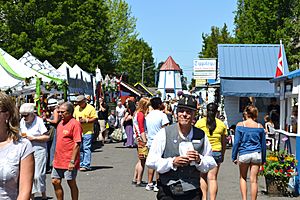Scandinavian Festival facts for kids
The Scandinavian Festival is a big four-day party held every year in Junction City, Oregon, United States. This festival celebrates the heritage of countries like Denmark, Sweden, Finland, and Norway. Even though Junction City is a small town with about 6,000 people, over 100,000 visitors come to the festival each year! Sunset Magazine even called it one of the best festivals in the U.S. because it feels so real and authentic. In 2014, the festival was honored as an Oregon Heritage Tradition.
Festival History
The Scandinavian Festival began in 1961. Dr. Gale Fletchall started it to help save his town. Many businesses in downtown Junction City were closing. This happened because a new highway, Interstate 5, went around the town. Most cars used to drive through Junction City on Oregon Route 99.
Dr. Fletchall wanted to find a way to bring the community together. He thought a big city party would be perfect. He decided to celebrate the town's Scandinavian roots. He talked to older Danish-American residents about his idea. In May 1961, the local chamber of commerce agreed to help pay for it.
Soon after, classes started for Scandinavian dancing and singing. Churches and other groups agreed to set up food and craft booths. The very first Scandinavian Festival opened in August 1961. Dr. Fletchall hoped for about 2,000 visitors. Instead, 25,000 people came! Today, it is one of Oregon's most popular events. In 2020, the festival was held mostly online due to world events.
Festival Activities
Since 1961, the festival has brought many visitors to Junction City. The downtown area changes into an old-world town for the event. Each day of the festival celebrates a different Scandinavian country. These countries are Denmark, Sweden, Finland, and Norway.
You can see many fun things at the festival. Costumed Vikings march down the street. There are puppet shows with traditional northern European stories. You can also see colorful costumes in a special fashion show. Storytellers share tales by Hans Christian Andersen. Folk dancers perform and even teach you some steps. Choirs and music groups play traditional Scandinavian songs. You can also take language classes or join the Scandia Run 10 km race.
Traditional Foods
The festival offers many delicious Scandinavian foods. Some popular treats include:
- Vandbakkelser: These are chocolate-dipped yum puffs.
- Æbleskiver: These are round, fluffy Danish pancakes.
- Swedish meatballs: A classic dish often served with gravy.
- Lefse: A soft Norwegian flatbread made from potatoes.
Festival Booths
The festival has many different stalls or booths. They fill most of the festival area. Most booths are set up along the streets. Some are indoors to offer shelter from the sun or rain. Food stalls are very popular at the festival. The Æbleskiver booth and the meat pie booth are especially well-known. They almost always have a large crowd waiting.
Other booths sell beautiful handmade crafts. You can find things like Hardanger embroidery and bobbin lace. There is also tatted lace and Rosemaling, which is a type of decorative painting. You can also see paintings, needlework, and ceramics. Many handmade toys are displayed too. These include puppets, wooden swords, and dolls. They show toys from a long time ago that kids can still enjoy today.
All the booths are expected to fit the festival's authentic Scandinavian theme. Sometimes, booth owners have had to change their designs. For example, one year, a lemonade stand looked like a giant lemon. The festival committee asked them to change it to match the theme. They tried to hide the lemon with traditional decorations, but it was a bit tricky!


